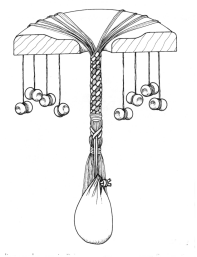|
Once you have invested in a Marudai, braiding becomes a more enjoyable experience. There is a medatative aspect to weaving on a marudai that can not be achieved on a cardboard loom. Plus the braiding goes a lot quicker.
Fibre
Traditionally, braids were made with threads of untwisted silk. Silk thread can be purchased commercially from a variety of providers, or you can grow it. Buying silk is expensive; growing it is a large commitment. The other option is to use another fibre. Some look nicer than others. Experiment to find out what you enjoy working with best.

Tama
On a marudai, the tension is kept by wieghted bobbins. These bobbins are called tama, and are generally made from turned wood, which is hollowed and filled with lead. Clay was also used in period. If you do not have acces to lathe, you can buy tama commercially - but they are expensive. 70 gram tama run approximately $6.50 each (USD), so a set of 16 will cost $104 plus taxes, shipping and handling, ect. This is a good investment, but is a little expensive if you're just starting out.
A cheaper option is using film canisters filled with pennies, or embriodery floss bobbins with weighted bags hanging from them.
A countreweight must be attatched to the emerging cord (see illustration). This weight should be approximately half the weight of the combined weight of all the bobbins. This is usually a bag which contains lead washers, but any sort of weight may be used.
The Transition to a Marudai
Working on a wooden loom is different from the cardboard in several ways:
~ there are no slots to keep the threads in the right place. This may seem daunting the first time you work on your new loom, but if the wood is finished properly, the threads should stay in place without catching.
~ weights keep the tension. There is no longer any need to keep the tension with your fingers, or to tighten any of your strings.
|

